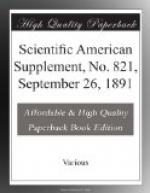Within the closet, in the left hand corner, a tall wooden box was placed, about two-thirds full of dry, well sifted wood ashes. The box also contained a small long-handled fire shovel. When about six inches of the ashes had been strewn into the vault the closet was ready for use. No; not quite; for squares of suitable paper had to be cut, looped together with twine, and hung within convenient reaching distance of the right hand; also a little to the left of this pad of paper, and above the range of sight when seated, a ten pound paper bag of the toughest texture had to be hung by a loop on a nail driven into the corner.
At first the rector thought that his guests would be “quick-witted enough to understand the arrangement,” but when he found that the majority of them were, as the Scotch say, “dull in the uptak,” he had to think of some plan to enforce his rules and regulations. As by-word-of-mouth instructions would have been rather embarrassing to both sides, he tacked up explicit written orders, which must have provoked many a smile. Above the bin of sifted ashes he nailed a card which instructed “Those who use this closet must strew two shovelfuls of ashes into the vault.” Above the pad of clean paper he tacked the thrifty proverb: “Waste not, want not;” and above the paper bag he suspended a card bearing this warning: “All refuse paper must be put into this bag; not a scrap of clean or unclean paper must be thrown into the vault.”
This had the desired effect. Some complacently united to humor their host’s whim, as they called it, and others, immediately recognizing its utility and decency, took notes with a view to modifying their own closet arrangements.
Sarah, the maid of all work, caused a good deal of amusement in the family circle by writing her instructions in blue pencil on the front of the ash bin. These were: “Strew two shuffefuls of ashes into the volt, but don’t spill two shuffefuls onto the floor. By order of the Gurl who has to sweap up.” This order was emphatically approved of by those fastidious ones who didn’t have to “sweep up.”
This closet opened off the woodshed, and besides being snugly weatherproof in itself, was sheltered on one side by the shed and on another by a high board fence. The other two sides were screened from observation by lattice work, outside of which evergreens were planted to give added seclusion and shade. A ventilator in the roof and two sunny little windows, screened at will from within by tiny Venetian shutters, gave ample light and currents of fresh air. For winter use, the rector’s wife and daughters made “hooked” mats for floor and for foot support. These were hung up every night in the shed to air and put back first thing in the morning. For the greater protection and comfort of invalids, an old-fashioned foot warmer, with a handle like a basket, was always at hand ready to be filled with live coals and carried out.




